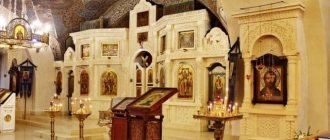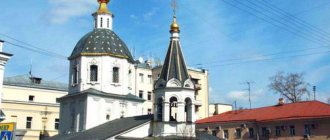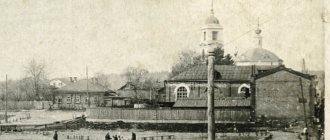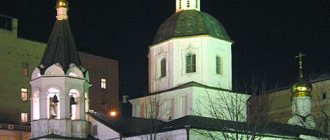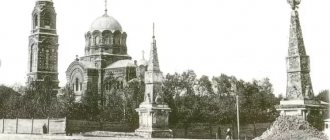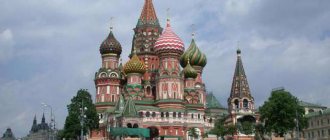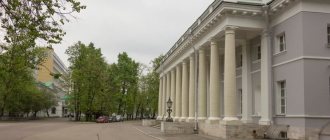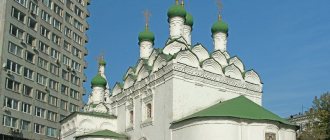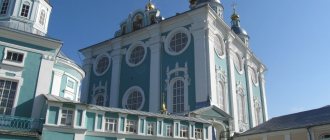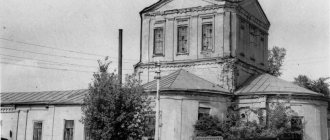Mir
Russia Moscow Temple of the Ascension on the Pea Field (Moscow) Map is loading...
{"format":"leaflet","minzoom":false,"maxzoom":false,"limit":50,"offset":0,"link":"all","sort":[""], "order":[],"headers":"show","mainlabel":"","intro":"","outro":"","searchlabel":"\u2026 \u0441\u043b\u0435\ u0434\u0443\u044e\u0449\u0438\u0435 \u0440\u0435\u0437\u0443\u043b\u044c\u0442\u0430\u0442\u044b","default":"","import-annotation":false,"width ":"auto","height":"350px","centre":{"text":"","title":"""link":"""lat":55.76389000000000351064954884350299835205078125,"lon": 37.67166999999999887904778006486594676971435546875,"icon":""},"title":"","label":"","icon":"","lines":[],"polygons":[],"circles":[ ],"rectangles":[],"copycoords":false,"static":false,"zoom":8,"defzoom":14,"layers":["OpenStreetMap"],"image layers":[] ,"overlays":[],"resizable":false,"fullscreen":true,"scrollwheelzoom":true,"cluster":false,"clustermaxzoom":9,"clusterzoomonclick":true,"clustermaxradius":80, "clusterspiderfy":true,"geojson":"","clicktarget":"","showtitle":true,"hidenamespace":false,"template":"","userparam":"","activeicon": "","pagelabel":false,"ajaxcoordproperty":"","ajaxquery":"","locations":[{"text":"\u003Cb\u003E\u003Ca href=\"/palomnik/%D0% A5%D1%80%D0%B0%D0%BC_%D0%92%D0%BE%D0%B7%D0%BD%D0%B5%D1%81%D0%B5%D0%BD%D0%B8% D1%8F_%D0%BD%D0%B0_%D0%93%D0%BE%D1%80%D0%BE%D1%85%D0%BE%D0%B2%D0%BE%D0%BC_%D0% BF%D0%BE%D0%BB%D0%B5_(%D0%9C%D0%BE%D1%81%D0%BA%D0%B2%D0%B0)\» title=\»\u0425\u0440\ u0430\u043c \u0412\u043e\u0437\u043d\u0435\u0441\u0435\u043d\u0438\u044f \u043d\u0430 \u0413\u043e\u0440\u043e\u0445\u043e\u 0432\u043e\u043c\u043f\u043e\ u043b\u0435 (\u041c\u043e\u0441\u043a\u0432\u0430)\»\u003E\u0425\u0440\u0430\u043c \u0412\u043e\u0437\u043d\u0435\u0441\u0435 \u043d\u0438\u044f\ u043d\u0430 \u0413\u043e\u0440\u043e\u0445\u043e\u0432\u043e\u043c \u043f\u043e\u043b\u0435 (\u041c\u043e\u0441\u043a\u0432\u 0430)\u003C/a\u003E\ u003C/b\u003E\u003Chr /\u003E\u003Ca href=\"/palomnik/%D0%A1%D0%B2%D0%BE%D0%B9%D1%81%D1%82%D0%B2%D0% BE:%D0%90%D0%BD%D0%BD%D0%BE%D1%82%D0%B0%D1%86%D0%B8%D1%8F\» title=\»\u0421\u0432\u043e \u0439\u0441\u0442\u0432\u043e:\u0410\u043d\u043d\u043e\u0442\u0430\u0446\u0438\u044f\»\u003E\u0410\u043d\u043d\u043e\u0442 \u0430\u0446\u0438\ u044f\u003C/a\u003E: »'\u0426\u0435\u0440\u043a\u043e\u0432\u044c \u0412\u043e\u0437\u043d\u0435\u0441\u0435\u043d\u0438\u04 4f\u0413\u043e\u0441 \u043f\u043e\u0434\u043d\u044f"', \u0441\u043e\u0433\u043b\u0430\u0441\u043d\u043e \u043b\u0435\u0442\u043e\u043f\u0438\u04 41\u043d\u043e\u043c\ u0443 \u043f\u0440\u0435\u0434\u0430\u043d\u0438\u044e, \u0438\u0437\u0432\u0435\u0441\u0442\u043d\u0430 \u0441\u043e \u0432 \u0440\u0435\u043c\u0435\u043d \u0438 \u0446\u0430\u0440\u0441\u0442\u0432\u043e\u0432\u0430\u043d\u0438\u044f \u0446\u0430\u0440\u044f \u041c\u0438\u0445 \u0430\u0438\u043b\u0430 \u0424 \u0435\u0434\u043e\u0440\u043e\u0432\u0438\u0447\u0430 \u0420\u043e\u043c\u0430\u043d\u043e\u0432\u0430, \u00ab\u0413\u043e\ u0440\u043e\u0445\u043e\ u0432\u043e\u0435 \u043f\u043e\u043b\u0435\u00bb \u043a\u0430\u043a \u043c\u0435\u0441\u0442\u043d\u043e\u0441\u0442\u044c \u 0438\u0437\u0432\u0435\u0441\ u0442\u043d\u0430 \u0441 1718 \u0433\u043e\u0434\u0430, \u0443\u043f\u043e\u043c\u0438\u043d\u0430\u0435\u0442\u0441\u044f \ u043f\u043e\u0437\u0434\u043d\ u0435\u0435 \u0438 \u043a\u0430\u043a \u00ab\u0411\u0430\u0441\u043c\u0430\u043d\u043d\u043e\u0435 \u043f\u043e\u043b\u0435\u 00bb.","title":"\ u0425\u0440\u0430\u043c \u0412\u043e\u0437\u043d\u0435\u0441\u0435\u043d\u0438\u044f \u043d\u0430 \u0413\u043e\u0440\u043e\u 0445\u043e\u0432\u043e\u043c\ u043f\u043e\u043b\u0435 (\u041c\u043e\u0441\u043a\u0432\u0430)","link":"","lat":55.76389000000000351064954884350299835205078125,"lon": 37.67166999999999887904778006486594676971435546875,"icon":""}] ,"imageLayers":[]}
55.764025; 37.671696
Russia, Moscow, Radio street, 2с1
Moscow
Russia
Telephone:
8-499-267-03-86
Church of the Ascension
, according to chronicle legend, has been known since the reign of Tsar Mikhail Fedorovich Romanov, “Pea Field” as an area has been known since 1718, and was later mentioned as “Basmannoe Field”.
History[edit]
According to ancient Moscow legend, the Temple existed here since the beginning of the 17th century, since the time of Tsar Mikhail Fedorovich Romanov.
The name of the area where the Temple is located comes from the State pea field located here. At first the area was called simply “field”, or “Basmanny field”, and for the first time in 1718 it was called “Pea field”. It was crossed by two paths, which later became Voznesenskaya (Radio) and Gorokhovaya (Kazakova) streets. At the intersection of these streets, the Church of the Ascension of the Lord on the Pea Field was built.
The owner of these lands was Count Gabriel Ivanovich Golovkin. In 1731, being in the rank of State Chancellor, Privy Councilor, various orders of Knight and Count, living here with his children and grandchildren, in his old age, he wished to have a (house) church at his home and submitted a petition for this in the name of Empress Anna Ioannovna. Permission was received and almost two years later, in 1733, the wooden church was built and consecrated.
In 1737 there was a big fire. Count Golovkin's house burned down and the church was badly damaged. On the site of the burnt wooden church, a single-altar brick church was built - which was the home church of the chancellor, and later Count Kirill Grigorievich Razumovsky. At that time it was called the church in the “Razumovsky Garden”.
In 1743, the estate began to belong to Count Alexei Grigorievich Razumovsky. Count A.G. Razumovsky, taking care of the organization of his home, did not forget the Ascension Church at his house and its clergy. In 1748, as can be seen from the protocols of the Moscow Ecclesiastical Consistory, there was a fire in the count’s house and “in the stone Church of the Ascension of the Lord, the floor inside and the roofs of the church were burned out.” Based on the resolution of the Holy Synod and Metropolitan Platon, the church was restored and re-consecrated.
By the second half of the 18th century. The pea field no longer became a field in the proper sense. The entire area of the field began to be built up by Russian noble and eminent people. All the nobility of the 18th century gathered here. And the beautiful area was decorated with beautiful palaces of eminent people Saltykovs, Golovins, Sheremetyevs, Dolgorukiys. We can say with confidence that in none of the outskirts of Moscow were there as many “country palaces” as in the Gorokhovskaya area.
In 1769, Razumovsky's house stone church of the Ascension of the Lord was renamed from a house church to a parish church. There is no doubt that such a change occurred not without the desire of the local residents and the will of the count himself. In the first metric book (1769-1771) it is written that the Church of the Ascension originally stood between the count’s main house and the former ponds.
Since 1769, the population of the surrounding areas increased and the church could no longer accommodate worshipers. In 1771, the question arose about its reconstruction “due to inability to accommodate.” Priest Peter Andreev and the parish people turned to Metropolitan Platon with a request to grant land for a new church. Plato imposed a resolution on the petition: “... to move the church to a new location, to formalize the transfer of land in a legal manner for the construction of a church and houses of clergy.” For the construction of the church, 2144 square meters of land were allocated and permanently transferred.
The old church that stood on the main alley of the Razumovsky Palace park was demolished. Between the part of the Razumovsky palace near the Chechora River, facing the street, and the main house, nestled the courtyards of the church clergy; to the north was the Church of the Ascension itself. The Chechora River, on the banks of which the temple was located, was enclosed in a pipe at the beginning of the twentieth century, along which Elizavetinsky Lane was located.
It is believed that the Church of the Ascension was built by the famous architect Matvey Fedorovich Kazakov, although no documentary evidence of this has been found.
Some researchers believe that several architectural forms characteristic of the style speak in favor of Kazakov’s authorship, for example, the rotunda where the main chapel is located. It is crowned with a low stepped dome, above which rises a light lantern. Kozakov loved these details very much and repeated them in other buildings (Church of Metropolitan Philip in Moscow, etc.).
According to the project by M.F. Kazakov built over 100 buildings in Moscow. He built it for Count Razumovsky in 1800-1802. Magnificent house (No. 18). Kazakov largely determined the architectural appearance of Moscow in the 18th and early 19th centuries.
That is why in 1939 Gorokhovaya Street was renamed Kazakova Street in honor of the architect’s 200th anniversary.
Voznesenskaya Street, which was named according to the original Moscow tradition - after the name of the church, was renamed Radio Street in 1929 in connection with the radioification of the city and the radio station built on it.
There is an oral tradition that the dedication of the right chapel to St. Nicholas the Wonderworker was the wish of the main investor in the construction of the temple - Nikolai Nikitich Demidov, especially since the church dedicated to the patron of his father - Nikita the Martyr was already nearby on Staraya Basmannaya Street.
The spiritual and material assistance of Metropolitan Platon and eminent parishioner Nikolai Demidov, as well as the prayers and daily efforts of priest Peter Andreev determined the success and relatively quick construction of the temple. This is what is written down in the church’s clergy registers, that “the church was built with the diligence of priest Peter Andreev using funds collected from willing donors and with the special assistance of parishioner Mr. Nikolai Nikitich Demidov and other parishioners.” The priest of the temple, Father Peter, for his high good qualities and special zeal for the newly built Church of the Ascension of the Lord, enjoyed the special attention and love of Metropolitan Plato.
Priest Peter Andreev, the builder of the temple, served as priest from 1775 to 1823. almost 50 years. Unfortunately, it was not possible to find evidence about him, but the fruits of his activities are obvious. It was through his prayers that a huge temple construction project was successfully implemented.
The rectangular bell tower was built together with the temple from brick. There were ten bells. On the large one was the inscription “Come to Me, all who suffer and are burdened, and I will give you rest, My yoke is good and My burden is light...” This bell was cast on May 12 during the reign of the Sovereign Emperor Alexander III.
The chapel of the Prophet Moses the God-Seer was erected in memory of the church of the Moiseevsky Monastery, which was located on Moiseevskaya Square between Okhotny Ryad and Tverskaya Street, which was abolished in 1789, among others, by the Manifesto of Empress Catherine II of February 12, 1764.
Bricks, other building materials and many church objects were transferred to the Church of the Ascension of the Lord, which was under construction, on the Pea Field in 1789.
This is the only chapel in honor of the Holy Prophet Moses the Seer of God in Moscow.
The miraculous icon of the Prophet is one of the most revered icons of the temple. It was brought to the Moscow church from distant Siberia. This is how the memory of the abolished Moiseevsky Monastery on Manezhnaya Square was immortalized, from whose bricks the Ascension Church was built. Parishioners believe that a special monastic spirit still lives in it.
In the Moiseevsky Convent there was the Church of the Annunciation of the Blessed Virgin Mary with two chapels on both sides of the Altar - in the name of the Prophet Moses the God-Seer and St. Nicholas the Wonderworker. Their abolition determined the dedication of the chapels in the new Ascension Church, especially since it grew on the stones of the dismantled church.
The start of construction was delayed, the parishioners had no money, and only when Nikolai Nikitich Demidov agreed to help them, and the church authorities gave away materials from the dismantled Moiseevsky Monastery, construction began.
It was erected not far from the old church. In 1787, land was allocated lying on the street leading to the Palace Bridge. “On the 25th of May 1788, on the day of our glorious present and future parish feast of the Ascension of the Lord, the solemn foundation of the new Ascension Church was completed,” as stated in the collection book.
The laying was called “solemn” because it was conducted by Metropolitan Platon in the presence of noble, great persons and parish people.
The temple with the Main Altar of the Ascension of the Lord, chapels in the refectory - the Prophet Moses and St. Nicholas the Wonderworker (renovated in 1872).
In 1793, on the 2nd of May, the consecration of the Church of the Ascension was carried out by Metropolitan Platon in the presence of noble persons - as one of the eyewitnesses of the great event wrote about it.
Metropolitan Platon (Levshin) was a very famous person in Moscow. He was called the “second Chrysostom”, “Moscow Apostle”, because he was a wonderful, brilliant preacher during the times of the Sovereigns Catherine II, Paul I, Alexander I.
In 1797, Metropolitan Platon presented a large-format Gospel in a silver-gilded frame with his own hand-written inscription: “... I give this book of the Gospel as a contribution to the Church of the Ascension of the Lord, which is in Moscow on the Pea Field to the priest Peter, Humble Plato, Metropolitan of Moscow, November 1797, 18 Bethany...” .
In later times, the famous collector of archival documents on the history of Moscow churches, Gavriil Ivanovich Kholmogorov, served as a deacon and then as a priest in the church. The work was carried out together with his brother Vasily Ivanovich under the leadership of the historian Ivan Egorovich Zabelin.
Gabriel Ivanovich Kholmogorov recently lived near the church on Voznesenskaya Street, 2/8, but his house has not survived.
Under Soviet rule, in 1933, the Temple was closed and the building was transferred to the club of the Aerodynamic Institute, then it housed a metalworking workshop and a printing house. The location of the icons and utensils taken from the church is unknown.
In 1941, an air bomb hit the temple building, damaging the dome and causing a crack to appear in the wall.
In the 1960s, a partial restoration of the architectural monument church was carried out.
Since 1973, the monument-temple was used by the Moscow production association “Upakovka” and it was constantly shaken by working printing machines.
In 1987, there was a fire that severely destroyed the interior. The painting on the facades, which existed back in the 1950s, has been partially lost.
After almost 70 years of neglect, the temple was transferred with great difficulty to the Russian Orthodox Church in 1992 by Decree of the Moscow Government No. 622 of 08/11/1992.
However, the temple was not completely vacated by the tenants. It was necessary to free the room from six toilets, utility rooms upstairs, from two reinforced concrete ceilings that had disfigured the interior of the rotunda, to clear the walls with lost paintings from traces of the fire of 1987 caused by the Upakovka cardboard factory - from all kinds of garbage.
The first water-blessing prayer service in the chapel of the prophet Moses the Seer of God was performed on the feast of Holy Epiphany on January 19, 1993. At the first Divine Liturgy on February 13, the chapel of the Prophet Moses the Seer of God was consecrated by the minor priestly rank of Archpriest Vasily Golovanov, who was sent as rector to serve and restore the temple at the end of 1992 by Decree of His Holiness Patriarch Alexy II.
The shrines of the Temple are: Cross-reliquary with particles of the relics of St. Nicholas the Wonderworker, St. Sergius of Radonezh, right. Simeon the God-Receiver and other saints of God; there are particles: the Holy Sepulcher, the Life-giving Cross of the Lord, the Sepulcher of the Mother of God; icons - the Mother of God “Unexpected Joy” and “Sovereign”, the Holy Prophet Moses the Seer of God.
In November 1998, the custodian Oleg Ivanovich Belchenko transferred the Image of the Holy Tsar Martyr Nicholas II to the church.
The rector of the temple, having accepted the icon of the blessed Tsar Martyr, read the Akathists to the Sovereign Mother of God and the Sovereign Holy Tsar Passion-Bearer.
The icon of the Sovereign streamed myrrh abundantly, and the temple was filled with fragrance.
Archpriest Vasily Golovanov was sure that the myrrh-streaming image of the Tsar ended up in the Church of the Ascension on the Pea Field not by accident, but by an event. There is oral testimony from eyewitnesses that the “Golden Royal Staircase,” made of oak with wide steps, led to the second floor of the priest’s house, which was previously located among other parish buildings to the right of the church. Tsar Nikolai Alexandrovich himself walked along it. The Emperor could not help but visit the women’s almshouse that existed near the temple. He repeatedly entered the Temple itself (of the Ascension of the Lord), where in the iconostasis of the St. Nicholas chapel there was an icon of the Fedorov Mother of God, the patroness of the House of Romanov.
His Holiness Patriarch of Moscow and All Rus' Alexy II wrote a resolution on the report of the rector of the Temple on the fact of the myrrh-streaming of the image of the Sovereign Passion-Bearer Nicholas II: “We consider the myrrh-streaming of holy icons as a manifestation of God’s mercy to us in this difficult time in which we live.”
Church of the Ascension on the Pea Field
Ascension on the Ponds
| Church of the Ascension on the Pea Field |
In the old days, the royal road to the country residences of Pokrovskoye and Rubtsovo passed through these parts.
It is believed that Tsar Mikhail Fedorovich founded the first wooden Ascension Church here. Then the royal pea field was sown on these free, spacious lands, where sweet and juicy peas were grown for the sovereign's table - in those days they were an indispensable dish and dessert. Over time, from the paths trodden in the field, Gorokhovskaya Street (now Kazakova Street) and Gorokhovsky Lane appeared - historian V.B. Muravyov considers it to be the oldest name preserved in this area. Since the time of Boris Godunov, a German settlement appeared on the right bank of the Yauza, where foreigners of numerous professions and prisoners settled. (Idle Muscovites used to say that foreigners sowed peas here for themselves.) And in the first half of the 17th century, there was already a wooden estate of the Danish merchant David Bachart, who established trade relations between Russia and Denmark. He laid out an orchard, beautiful ponds, and erected a wooden mansion. At the very beginning of his reign, Peter I planned to make the German Settlement the center of Moscow and create a single ensemble on both banks of the Yauza. Later this served as a prototype for St. Petersburg, and after the founding of the northern capital, Peter dreamed of a waterway between St. Petersburg and Moscow, which included the Yauza: the German settlement was to become the main pier. This plan did not come true, but in the years of Peter the Great, Russian nobility began to settle here.
The pea field has been documented since 1718, when State Chancellor Gavrila Ivanovich Golovkin settled in the former estate of a Danish merchant, the Bakhartov Metochion, and the wooden Ascension Church became his parish church. The new owner of the estate, a descendant of an old boyar family, was a relative of Tsarina Natalya Kirillovna Naryshkina. Under Princess Sophia, he remained faithful to young Peter and in the terrible August of 1689 even accompanied him to the Trinity Monastery, where he rode away at night from Preobrazhensky, thereby forever gaining his trust. Golovkin Sr. traveled with the Tsar to Europe, participated in the Battle of Poltava, for which he received the title of Chancellor, was on the Prut Campaign, and headed the Ambassadorial Prikaz and the College of Foreign Affairs. Golovkin was also trusted by Catherine I, who appointed him guardian of the young Emperor Peter II. After the death of the young autocrat, he supported Anna Ioannovna.
However, the skilled courtier was extremely stingy. Living in his estate on Gorokhovoye Pole, he went to the old wooden Ascension Church for many years, and only when it burned down did he ask permission to build a stone church, consecrated in 1733, and even then small in size, like a house church. The church began to be called “Ascension on the Ponds.” And the next year the owner died.
His unfortunate son Mikhail became the new parishioner of the temple and the owner of the estate. Not being as experienced in political intrigue as his father, he fell victim to them, although everything started out as well as possible. In 1722, he was married to Ekaterina Ivanovna Romodanovskaya, goddaughter of Peter I and granddaughter of Prince Caesar Fyodor Romodanovsky, who headed the Preobrazhensky order and political investigation. The wedding marshal was Peter himself, and the arranged mother was Catherine I. The bride turned out to be so timid and fearful (this was considered a high feminine virtue) that at the wedding, when the priest asked if she agreed, the groom answered in the affirmative instead of her. With the dowry, the Golovkins took possession of another local estate at 10 Voznesenskaya, which previously belonged to the bride’s father, Prince I.F. Romodanovsky. Then Peter sent Golovkin Jr. as ambassador to Berlin.
Together with his father, he supported Anna Ioannovna and enjoyed her trust, especially since his wife was the new empress’s cousin. The autocrat entrusted him with financial affairs and appointed him director of the Mint. He remained politically afloat even after the fall of Biron. The next ruler, Anna Leopoldovna (niece of Anna Ioannovna), granted him vice-chancellor, and it was then, after the death of his father, that he showed complete political shortsightedness, which actually cost him his life. Golovkin advised Anna Leopoldovna, regent under her son Ivan Antonovich, to proclaim herself empress and refused to take the side of Elizabeth Petrovna. That is, at a critical political moment, he supported the wrong person. And when Peter’s daughter ascended the throne in December 1741, Golovkin was accused of high treason, sentenced to death, but was pardoned and exiled to Yakutia along with his faithful wife - she refused to renounce her husband in exchange for a position at court. In exile, 15 years later, Golovkin died, his wife obtained permission to bring his body to Moscow and buried him in the St. George Monastery, where she herself ended her days at a ripe old age and in honor.
In the same 1741, Empress Elizabeth confiscated all of Golovkin’s possessions. His wife's estate was sold to the famous mining owner Nikita Akinfievich Demidov, grandson of the founder of the dynasty. Since the estate was located in the German settlement, the Demidov house, probably rebuilt by F. Argunov, began to be called Slobodsky. It was here that the marble busts of the owners were kept, executed by the great Fyodor Shubin, whom Nikita Demidov helped to establish himself as a sculptor. There were also greenhouses, menageries and, most importantly, a serf theater, presumably built by Matvey Kazakov. All this will one way or another resonate in the history of the Ascension Church, which without the Demidovs might not have survived to our time. The Empress took the Golovkins' family estate on Gorokhov Field to the treasury and the next year, 1742, gave it to her favorite Alexei Grigorievich Razumovsky. From this date begins the history of the Ascension Church, which has survived to this day.
Hosts and parishioners
Razumovsky, on the contrary, supported Elizaveta Petrovna during the palace coup, for which he received her favor and love. Nothing foreshadowed such a rapid rise in his life - from a Ukrainian shepherd to a nobleman and, probably, the secret spouse of the Russian Empress. He was born in 1709 into the family of a Cossack Grigory Rozum - Rozum (in Ukrainian “mind”) was his father’s nickname, since when drinking wine he used to repeat: “What a head, what a rozum!” After a quarrel with his father, Alexey left home and earned his living by singing in church, for he had a beautiful and strong voice, for which he was taken into the court church choir in St. Petersburg in 1731. Princess Elizabeth, who adored good singing, drew attention to the handsome young man and promoted him to her retinue as a chamberlain, and then he became his favorite. His Little Russian origin was transferred to Polish, the Cossack son turned into a descendant of the nobleman Rozhinsky, and already in the fall of 1742, it is believed, their secret wedding took place with the Empress in the village of Perovo. Many researchers consider this marriage to be a reliable fact, although it was so secret that Catherine the Great herself knew nothing about it and tried to find out with various diplomatic tricks. After the coronation of Elizabeth, Razumovsky was granted the title of count and huge land holdings. In Moscow, he received an estate on Gorokhovoy Pole, confiscated from Golovkin. Perhaps it was a gift from the empress to her secret husband (rumor linked this gift with the palace on Pokrovka). So another famous parishioner appeared in the Ascension Church.
After the death of A.G. Razumovsky in 1771, the estate passed to his younger brother Kirill. The new owner of the estate, who also herded oxen as a child, was a favorite of both empresses - Elizabeth Petrovna and Catherine II. Having reached political Olympus, he kept his shepherd's pipe and clothes in a closet, often showing these relics to his children as a reminder of their true origin. Having married Ekaterina Ivanovna Naryshkina, a distant relative of Empress Elizabeth, he served as both the president of the Academy of Sciences and the hetman of Little Russia, since during the rule of the Razumovskys at court, the Ukrainians took advantage of the favorable moment and asked the empress to return the hetmanship to them. Then he received the rank of field marshal general. According to legend, it was to Kirill Razumovsky that Russia owed the widespread “Gallomania” and the transition of Russian high society to the French language. His eldest son Alexey, named after his uncle, from a young age embarked on all the hardships of high society life and spent colossal sums on his wardrobe. One day a tailor brought a bill for 20 thousand rubles. The angry father showed his son the peasant clothes he wore in his youth and asked if he was ashamed to spend that kind of money on a dress? To which he sensibly answered him: “Remember that there is a huge difference between us: you are the son of a simple Cossack, and I am the son of a Russian field marshal general.”
Indeed, Alexei Kirillovich Razumovsky, according to his contemporaries, had exorbitant pride, considered himself a person of royal blood and rebuilt the estate on the Pea Field, which he inherited, in accordance with his ideas of greatness. In 1799, he begged his father to sell their Moscow house on Vozdvizhenka to Count Sheremetev and, with the proceeds, an astronomical sum of 400 thousand rubles, began construction of a new luxurious estate and a new parish church of the Ascension. Both of these buildings are considered the creation of Matvey Kazakov, although this is not documented. St. Petersburg architect N.A. is also named as a possible author of the estate project. Lvov (the author of G.R. Derzhavin’s house on Fontanka), and Adam Menelas, who worked under his leadership, and sometimes even Charles Cameron, the builder of the palace of Pavlovsk.
The mansion was built traditionally for Moscow - the main house is behind a large front courtyard, and the wings overlook the red line of the street. It is interesting that only the base of this house is made of stone, and the residential apartments are built of oak, since Razumovsky considered wood to be good for health, and stone to be harmful. The entrance was guarded by mighty lions, guarding the treasures that were hidden behind the walls: mirrors, bronze, tapestries, a mineralogical cabinet, paintings, sets, a library. There are beautiful gardens with ponds all around. Everything was done so that the owner could “in the midst of the noisy White Stone have a place that, with the charm of unartificial nature, would make a person forget that he is in the city, and would serve as an accurate and faithful refuge for calm after work, and the work of a statesman is great!” – wrote the old guidebook, referring to Razumovsky’s career. Trustee of Moscow University, A.K. Razumovsky was appointed Minister of Education in 1810 and, together with M.M. Speransky participated in the creation of the Tsarskoye Selo Lyceum. He was also among those who took the famous examination of the young Pushkin when he publicly read his poems. There is a legend that after the exam, Razumovsky hosted a gala dinner and invited the poet’s father, Sergei Lvovich, to it. At the table, he told him that he wanted to educate his son in prose, to which Derzhavin exclaimed: “Leave him as a poet!”
Under Alexei Kirillovich, a new Ascension Church was built, although by that time it was no longer a house church - the local population was increasing more and more, and in 1771 it became a parish church.
By the way, in the same year, Catherine II ordered that the painter Peter Semenov, who was engaged in the restoration of paintings in the Kremlin cathedrals, be elevated to the rank of deacon of the Ascension Church, for which, by order of the Empress, he was then ordained to the rank of priest.
The small house church from the time of Chancellor Golovkin could no longer accommodate all the pilgrims who dreamed of building a new church for themselves, but did not have the money for this. It was then that a powerful neighbor, N.A., came to their aid. Demidov. He made a large donation, although it is often believed that his son Nikolai Nikitich made a contribution to the temple. However, at the time of the donation, Nikolai Nikitich was at most 15 years old, and he was hardly the only one managing such sums. The donation was made during the life of Nikita Akinfievich, who died a year and a half after the foundation of the temple, and the rest of the construction could actually be supported by his son. In any case, the current temple is another fruit of Demidov’s blessings.
New Ascension
| Church of the Ascension on the Pea Field |
After Demidov’s contribution, the church authorities gave permission for the construction of the temple and, for their part, helped him - they gave him building materials from the ancient Moiseevsky Monastery in Okhotny Ryad, which stood on Manezhnaya Square, which was dismantled in those years.
Thus, the current miraculously surviving Church of the Ascension brought to us the warmth of distant Moscow antiquity. The main altar of the temple was consecrated in honor of the Ascension of the Lord, and one of the side chapels was consecrated in the name of Saint Moses the Seer of God, in memory of the Moses Monastery. Construction of the temple began in 1788, and Matvey Kazakov was probably invited for it: his authorship is evidenced by the characteristic Kazakov handwriting. This church is considered a rare and best example of early Moscow classicism. It largely reflected the stormy vicissitudes that Russian church architecture experienced during the era of classicism, when, as one researcher put it, a European wig was put on a Russian architect. The church was built by a ship: the temple, the refectory and the adjacent three-tier bell tower above the western entrance are located on the same axis, and the space of the temple is elongated, which is sometimes considered borrowed from Western European basilicas. The temple itself is round in plan, with a vertical axis, which is sometimes seen as a contradiction with the symbolic main role of the iconostasis in traditional Russian churches, where it logically completes the horizontal axis of the temple as a visible image of the Heavenly Church. Although here, too, a huge iconostasis dominates, occupying the main part of the temple.
The majestic temple is crowned with a Cossack miniature rotunda, like that of the Church of St. Philip on 1st Meshchanskaya, and the graceful bell tower-spire is decorated with sparkling stars. (It is believed that the first church spire appeared not in the northern capital, but in Moscow on the Menshikov Tower.)
And yet the church turned out to be cozy and warm in a Moscow way. The place chosen for it was extremely successful, a little further from Razumovsky’s house, where the old temple stood. Built on a hill, it became a local town-planning dominant - its powerful dome with a rotunda and bell tower were visible from afar. At the beginning of the 19th century, on patronal feast days, there were noisy folk festivals here, and the rich public walked that day in the garden of Count Razumovsky.
In 1800, the great Russian actor Pavel Mochalov, a serf of Nikolai Nikitovich Demidov, who inherited the house after the death of his father in 1789, was baptized in the Church of the Ascension. His parents Stepan Fedorovich Mochalov and Avdotya Ivanovna were actors in Demidov’s home theater. In 1803, the master leased Mochalov’s father to the Moscow Theater, and three years later the Mochalovs received their freedom. It is known that Pavel Stepanovich Mochalov was a deeply religious man. Possessing a rare memory, from childhood he memorized prayers and Gospel verses by ear, prayed all night long, on his knees, especially diligently during thunderstorms, and constantly went to church. Everyone thought that he would be a monk, but he chose the family acting craft, which turned into a real spiritual art for him - even his contemporaries noted the connection between his acting and his faith. Mochalov Jr.'s theatrical debut took place in 1817 in the tragedy "Oedipus in Athens", presented in Apraksin's house on Znamenka, where the troupe of the Moscow Imperial Theater (in the future - the Maly Theater) then joined. He was called the first Russian tragedian. According to contemporaries, he was an extraordinary, amazing actor, unlike the traditional actors of his time. He was small, even small in stature, angular, stooped, he did not recite, but spoke from the stage, was very active, did not hold back his emotions and gave himself over entirely to a passionate impulse, playing with his soul, which was then considered ignoble manners. Among his admiring admirers were Dostoevsky, Granovsky, and the young Saltykov-Shchedrin. Mochalov played Chatsky in the first production of Griboedov's comedy on the Moscow stage. He played all the tragic characters of Shakespeare - Hamlet, Othello, King Lear, and took on the role of Romeo at the age of 40.
But Emperor Nicholas I did not like Mochalov. The actor drank heavily and had manners as extraordinary as his acting. Once the sovereign came to Moscow and wanted to see Mochalov, but he went to the Donskoy Monastery for mass. As a result, he was sent to retire in 1837, having served on the stage of the imperial theater for 20 years. In his free time, the actor always visited churches, especially loved to go to the Kremlin cathedrals in the spring and looked at them as if he had never seen them before. Often for mass and all-night vigil I went to the Great Cross Church of St. Nicholas the Wonderworker on Ilyinka, stood thoughtfully on its porch and walked around for a long time, looking at the temple. His premonition did not deceive him - his funeral service was held in this church in March 1848. Having fallen through the ice, he died of a cold with a prayer on his lips: “We worship your cross, Master.”
Let's digress a little, let's mention that his former master Nikolai Nikitich Demidov, Potemkin-Tavrichesky's adjutant, equipped the Demidov regiment at his own expense in 1812 and himself participated in the Battle of Borodino. Then he donated his Moscow house on the Yauza to the House of Diligence, where the Elizabethan Institute of Noble Maidens was later located, and in Soviet times - the Regional Pedagogical Institute named after. Krupskaya. The most famous of all was his son Anatoly, who married Napoleon's niece and became the Russian malachite king when large deposits of malachite were discovered. The Malachite Hall of the Winter Palace and St. Isaac's Cathedral are decorated with Demidov malachite. Continuing family traditions, it was he who commissioned Bryullov’s painting “The Last Day of Pompeii.”
At the beginning of the 19th century, the Pushkins became parishioners of the Ascension Church. According to Sergei Romanyuk, in October 1811 S.L. Pushkin rented an apartment in the house of A.Ya. Bulgakov on Voznesenskaya Street, and here his son Mikhail was born, baptized in this church. Judging by the metric books of the temple, the Pushkins lived here in the first half of 1812, and it was probably from here that they left for Nizhny Novgorod before Napoleon’s army entered Moscow. The Ascension Church as the home church of the Razumovskys is also mentioned on the pages of “War and Peace” by Leo Tolstoy. It is believed that it was in it that Natasha Rostova fervently prayed for victory for the Russian army. Then the news spread that the beautiful house of Count Razumovsky was burned to the ground, but this turned out to be a rumor. The fire of 1812 almost did not touch this area, so the house retained its original wooden walls. Moreover, it housed the headquarters of the Napoleonic marshal, so that soldiers protected the house from fire.
After the Patriotic War A.K. Razumovsky retired, but in 1818 the entire court visited his house on Gorokhovoy Pole. He asked the emperor to buy this house to pay his numerous debts, but he was refused. Six years later, the owner died, and according to his daughter’s stories, he - a Mason and Voltairian - repented before his death and kissed the cross. He left numerous illegitimate children born outside his legal but unsuccessful marriage with Countess Varvara Sheremeteva (sister of Count Nikolai Petrovich, who married Praskovya Zhemchugova). Illegitimate children received the surname Perovsky from the Perovo estate near Moscow, where Count Razumovsky and Elizaveta Petrovna once got married. From this family came the People's Wolf Sofya Perovskaya, the mother of the writer Alexei Konstantinovich Tolstoy Anna Perovskaya, Alexey Perovsky (Pogorelsky), the author of the fairy tale “The Black Hen, or the Underground Inhabitants,” and Vasily Perovsky, one of the many contenders for the prototype of Pierre Bezukhov.
After the death of A.K. Razumovsky's estate on Gorokhovoye Pole passed to his legitimate eldest son Peter, known for his extravagance. The magnificent palace quickly fell into disrepair, but fortunately the temple no longer depended on it. In 1827, Adam Mickiewicz, exiled to Russia for his free-thinking ideas about the liberation of Poland, lived in one of the estate outbuildings. Here he was visited by Pushkin, who often visited these parts, for his beloved uncle Vasily Lvovich Pushkin lived on Staraya Basmannaya. Just a year earlier, the poet returned from Mikhailovsky exile and came to his uncle immediately after the famous meeting with Nicholas I in the Kremlin on September 8, 1826.
And in 1828, Razumovsky’s estate was sold for next to nothing in order to pay off the numerous debts of the new owner. It went to some Odessa merchant, who was engaged in selling priceless books, porcelain and other collections of Razumovsky in antique shops. Only in 1833, the Razumovsky estate was bought by the Board of Trustees as a shelter for children whose parents died during the cholera epidemic. Later it became the Alexandrinsky Orphanage Institute or, as it was colloquially called, the Razumovsky boarding school. In the summer of 1876, A.I. entered this boarding school. Kuprin, where he tried to write his first poems. And since 1901, the house has housed an almshouse for honored teachers of charitable institutions of Empress Maria Feodorovna.
Since 1865, Gabriel Kholmogorov, a young graduate of the Bethany Theological Seminary, became a deacon of the Ascension Church. In 1900 he became its priest and remained so until his death in 1924. He was a famous collector of archival documents on the history of Moscow churches and temples of the Moscow region, which he compiled together with his older brother Vasily.
Now it has become known that Emperor Nicholas II visited the Church of the Ascension. It contained the revered Theodore Icon of the Mother of God, the patroness of the Romanov dynasty, decorated with enamel. The following historical coincidence was noted: peas in Rus' were sown on May 6, the day of the righteous Job the Long-Suffering, this day was even called “pea”. And it was on this day, May 6, 1868, that Emperor Nikolai Alexandrovich was born. His connection with the Ascension Church mystically continued in our days.
Morning is coming, but it's still night
After the revolution, the temple remained active for quite a long time, although toponymic changes began. In 1922, Voznesenskaya Street was renamed Radio Street - after the country's first Central Radiotelephone Station, built here in 1921. And in 1939, Gorokhovskaya became Kazakov Street - on the 200th anniversary of the architect’s birth, because then it was considered proven that Kazakov built his masterpieces here. The temple continued to function. In May 1923, chemist Nikolai Evgrafovich Pestov and Zoya Veniaminovna Bezdetnaya were married there. Pestov remains in memory for the fact that he went through a difficult and extraordinary path from a scientific atheist and a convinced communist, a participant in the civil war and a district military commissar to a deeply religious person in the cruel years of church persecution, an Orthodox thinker. His conversion took place miraculously: on March 1, 1921, he saw Christ in a dream, and the dream shocked him so much that his whole life changed - from then on he constantly felt the presence of the Lord in his heart. He returned to the Moscow Higher Technical School (now the Bauman Technical University), because his studies were interrupted by the First World War, and became a member of the Christian student circle, led by the leader of the Russian Christian student movement V.F. Martsinkovsky, a well-known opponent of Lunacharsky in religious disputes. In the circle, Pestov met his future wife. In 1922, he left the party, got married the next year, and soon after the wedding settled on Staraya Basmannaya.
In 1924, after Lenin’s death, the activities of student circles that preached the Gospel among students were prohibited, Nikolai Evgrafovich ended up in Butyrka prison, where he met a parishioner of the Church of St. Nicholas the Wonderworker on Maroseyka. So, after his release, he became the spiritual child of the rector of this church, Father Sergius Mechev (son of the famous Moscow priest righteous Alexy Mechev) and remained so until the arrest and deportation of the shepherd in 1929. Soon the St. Nicholas Church was also closed, but its most faithful parishioners began to meet secretly in apartments, including in Pestov’s house, where a small “house” church was built in one of the rooms. Divine services were performed by priests of closed Moscow churches. In the evenings, confession took place in Pestov’s office; those waiting sat in the corridor. In the morning they served a liturgy, during which they sang “like mosquitoes buzzing,” recalled Pestov’s daughter.
After the Great Patriotic War N.E. Pestov stopped hiding from his colleagues and openly visited the temple, and then he decided to write his own works on theology. His closest friends were wonderful neighbors - Russian businessman Nikolai Aleksandrovich Varentsov and Nikolai Pavlovich Poniatovsky, they were called “the three Nikolai from Staraya Basmannaya”. The son of the deacon of the Zamoskvorechsky Church of St. Nicholas the Wonderworker in Tolmachi, Nikolai Poniatovsky also served in the Red Army, then studied at the Military Medical Academy, but signed a protest of believers against the closure of the Trinity-Sergius Lavra and was expelled. A few years later, he managed to enter the medical faculty of Moscow State University, and later he became the personal physician of His Holiness Patriarch Alexy I. Three of Pestov’s grandsons accepted the priesthood, and after the closure of the Ascension Church and moving to a new apartment, he himself became a parishioner of the Church of Elijah the Ordinary until his death. which followed in 1982.
In the Ascension Church itself, shortly before its closure in 1933 or 1935, the new martyr Peter Ivanovich Kanardov (Konardova) served - first as a deacon, then as a priest, and lived with his family in the church house. Probably, after the closure of the temple, he was transferred to the Church of John the Baptist of the Moscow Diocese, but was soon arrested on a denunciation for counter-revolutionary activities and exiled to Kazakhstan, and there he was shot on November 28, 1937 on a new charge. The place of his grave remained unknown, just as not a single photograph of him survived, so the icon, which is now in the Church of the Ascension, was created from a pencil portrait written from memory by his relative. Another priest and new martyr of the Ascension Church, Archpriest Dmitry Bayanov, was shot at the Butovo training ground on December 10, 1937.
By that time the church had already been transferred to the club of the Aerodynamic Institute. Subsequently, it housed a metalworking workshop, a dormitory, a printing house, warehouses, production workshops and an exhibition hall, and during the war - a bomb shelter, and then a theater hall. Gogol. In the 1960s, a light restoration of the disfigured building took place, but then it was occupied by the printing house of the Upakovka production association, and then the temple was transferred to the State Choir of the Moscow Regional Philharmonic, probably for its good acoustics.
And in the Razumovsky Palace the Institute of Physical Culture was located, which was named after Stalin. The priceless monument was quickly turned into ruins, and they were going to restore it for the Olympics, but to no avail - they didn’t make it in time for the “date” and the work was curtailed. After 1980, various sports organizations were located in the estate building, but the All-Union Scientific Research Institute of Physical Culture dominated. In addition to classrooms and gyms, a bathhouse was built in the central part of the palace. Conscientious Muscovites wrote letters to various authorities, to the Soviet Cultural Foundation and personally to Academician D.S. Likhachev with a request to save the monument and use it to host a fund, concerts and exhibitions. In the 1990s, the protracted process of transferring the palace to the Academy of Arts began, but so far it is in a deplorable state.
In 1990, according to a letter from Patriarch Alexy II, the executive committee of the Moscow City Council transferred the Ascension Church to the Russian Orthodox Church. Services there began in 1993. During this time, it has been beautifully restored, although not yet completely. His shrines were a silver reliquary cross with particles of the relics of St. Nicholas the Wonderworker, St. Sergius of Radonezh, Righteous Simeon the God-Receiver, St. Andrew of Crete and other saints of God, a piece of the Holy Sepulcher, a piece of the coffin of the Mother of God and a piece of the Life-giving Cross of the Lord, the icon “Unexpected Joy”, which streamed myrrh in December 1998, as did the Sovereign Icon and the image of St. Nicholas the Wonderworker.
The returned Ascension Church became the center of veneration for Tsar Nicholas II long before his canonization. Here was also the myrrh-streaming icon of Nicholas II, painted before the glorification of the Tsar and previously kept in the house of a Muscovite woman. The streaming of myrrh began on November 7, 1998, exactly on the anniversary of the revolution; a few days later the image was transferred to the temple, where it remained until the end of February 1999, and all this time it streamed myrrh, according to the rector, almost every third day. Moreover, the strongest fragrance and abundant myrrh flow occurred on days associated with events in the life of the royal family and the history of Russia. One day, a regular four-pointed cross formed from the world and healings took place, about which the rector of the church, Archpriest Vasily Golovanov, reported to His Holiness Patriarch Alexy II and Metropolitan Juvenaly, chairman of the Synodal Commission for Canonization. Crowds of pilgrims flocked to the Ascension Church - the miracle was perceived as a sign of the impending glorification of the sovereign and forgiveness of the Russian people for apostasy. Memorial services were also held here for the murdered royal martyrs. And on August 10, 2000, with the blessing of His Holiness the Patriarch, a particularly solemn memorial service was held in the Church of the Ascension for members of the royal family in anticipation of their canonization at the Jubilee Council of Bishops of the Russian Orthodox Church. At the same time, a prayer service was served for the successful outcome of the Council, so that it would end with the canonization of the royal martyrs and all those who suffered for the faith during the years of Bolshevik persecution. At this Council the last Russian sovereign, members of his family and the new Russian martyrs were glorified.
Now in the temple there is an icon of the passion-bearer king, presented to the rector on the day of the angel, which also streamed myrrh, and another image of the sovereign with a shrine - a set sliver with a particle of blood from the Ipatiev House, which, as you know, stood opposite the Church of the Ascension of the Lord.
In preparation, materials from V.B. Muravyov, S.K. Romanyuk, Valery Lyubartovich and the site https://moskva.kotoroy.net were partially used
Current state[edit]
At the temple there are:
Sunday school for adults[edit]
In the Church of the Ascension of the Lord on the Pea Field, every Saturday from 14:30 to 16:30 Sunday school classes for adults are held to study the Church Slavonic language, the Basic Dogmas of the Orthodox Church and all Orthodox holidays, including tea drinking.
Everyone is welcome.
Sunday school for children[edit]
On Sundays after the Divine Service at 12.00
We invite children from 3 years of age to study the Law of God, as well as to engage in creative work (crafts, drawings, applications) and learn English. Children's matinees (Christmas and Easter) are held annually.
In our Sunday school, every Sunday there are classes in which, in the form of a tabletop theater, children are told the basics of the Law of God, the lives of saints, and Orthodox holidays. Toys and crafts are made in a creative environment.
In our classes, children draw Orthodox cartoons. On December 20, the first cartoon festival was held with the display of works by students of our Sunday school: “Creation of the Visible World”, “Chimes”, “Apostle Andrew the First-Called”. After the screening and a friendly tea party, the authors were awarded.
Our school also offers English classes in an entertaining way.
Working with youth[edit]
On Tuesdays, once every 2 weeks at 19.00, “Gospel Circle” meetings are held with tea drinking. Study of the Acts of the Apostles (led by Alexander Valentinovich Lozhkin).
We invite those interested. Next meeting after summer holidays.
On Wednesdays at 19.00 Gospel conversations with youth and adults are held (conducted by Vadim Pugin)
Social activities[edit]
Responsible for social service at the parish is Alexander Ivanovich Drevitsky.
Phone: 8-926-792-40-14
Activities: helping the homeless and those in difficult life situations (clothing, food, sending them home or to the hospital, assistance in finding a shelter, assistance in obtaining documents to replace lost ones, psychological assistance).
A point for distributing clothes and shoes to those in need has been opened at the temple.
